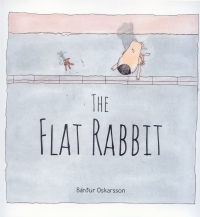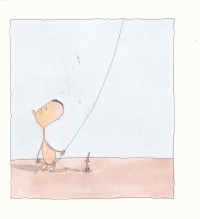| ________________
CM . . .
. Volume XXI Number 9 . . . . October 31, 2014
excerpt:
The Flat Rabbit is a thoughtful and charming picture book about two animals dealing with the body of a dead rabbit. The book is written and illustrated by Faroese children’s writer, illustrator, and artist Bárður Oskarsson, and beautifully translated by Marita Thomsen. The dog and the rat discover a flat rabbit in the street and decide that something must be done for her. They spend some time and energy deciding whether they should move the flat rabbit, and, if so, where to. Eventually they build a kite, tape the rabbit to it, and then fly her high above the city. The book ends on a very open note; the dog asks the rat “Would you like a turn [of the kite]?” The book leaves its content very open to interpretation. While the representation of the rabbit’s corpse is quite undignified, the animals’ response to her death is thoughtful and liberating, in an abstract way. One could read the book as a meditation on the inevitability of our death, a representation of the difficult process of dealing with the practical tasks of death, as a representation of the release of the soul after death, etc. The careful simplicity of the text and images allows readers to take many meanings from the book. The Flat Rabbit is the sort of book which might make adults uncomfortable but would probably not trouble children who are still young enough to be engaged by the process of death and decay. I would recommend the book for 6-10 year olds as they are likely to be interested in the practical aspects of death while still being open to different ideas about the emotional and social aspects of death. Highly Recommended. Lian Beveridge is an independent scholar based in Melbourne, Australia. Her primary research interests are children’s literature (especially picturebooks) and queer theory.
To comment on this title or this review, send mail to cm@umanitoba.ca.
Copyright © the Manitoba Library Association. Reproduction for personal use is permitted only if this copyright notice is maintained. Any
other reproduction is prohibited without permission.
CM Home | Next Review | Table of Contents for This Issue - October 31, 2014 | Back Issues | Search | CM Archive | Profiles Archive |

 Oskarsson’s sparse watercolour illustrations are carefully planned and lovely. They frequently play with perspective. For instance, the horizon sits very low in the page in many illustrations, and so the main characters seem very small. Several illustrations are from a bird’s eye view, which I imagine foreshadows the perspective of the rabbit when she is flying on the kite. These changes in perspective invite the reader to literally think about the situation from different perspectives. Another detail I enjoyed were the small images above the text on the left hand side of the page which foreshadow upcoming events or reference past events. These little clues reward re-reading and provide evidence to support different understandings of the text.
Oskarsson’s sparse watercolour illustrations are carefully planned and lovely. They frequently play with perspective. For instance, the horizon sits very low in the page in many illustrations, and so the main characters seem very small. Several illustrations are from a bird’s eye view, which I imagine foreshadows the perspective of the rabbit when she is flying on the kite. These changes in perspective invite the reader to literally think about the situation from different perspectives. Another detail I enjoyed were the small images above the text on the left hand side of the page which foreshadow upcoming events or reference past events. These little clues reward re-reading and provide evidence to support different understandings of the text.